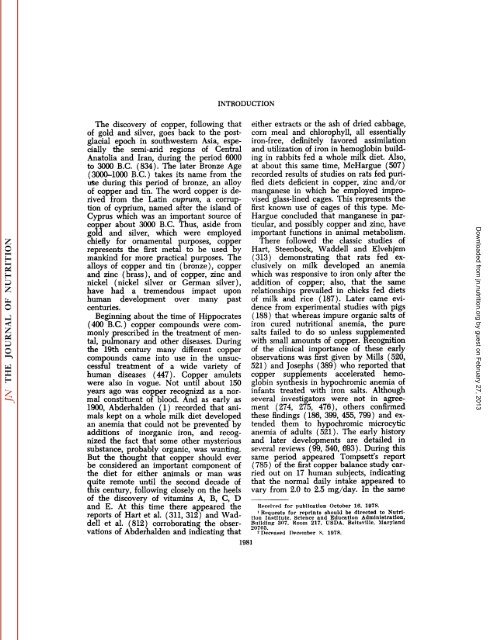conspectus of researchon copper metabolism and requirements
conspectus of researchon copper metabolism and requirements
conspectus of researchon copper metabolism and requirements
You also want an ePaper? Increase the reach of your titles
YUMPU automatically turns print PDFs into web optimized ePapers that Google loves.
INTRODUCTION<br />
The discovery <strong>of</strong> <strong>copper</strong>, following that<br />
<strong>of</strong> gold <strong>and</strong> silver, goes back to the post<br />
glacial epoch in southwestern Asia, espe<br />
cially the semi-arid regions <strong>of</strong> Central<br />
Anatolia <strong>and</strong> Iran, during the period 6000<br />
to 3000 B.C. (834). The later Bronze Age<br />
(3000-1000 B.C.) takes its name from the<br />
use during this period <strong>of</strong> bronze, an alloy<br />
<strong>of</strong> <strong>copper</strong> <strong>and</strong> tin. The word <strong>copper</strong> is de<br />
rived from the Latin cuprum, a corrup<br />
tion <strong>of</strong> cyprium, named after the isl<strong>and</strong> <strong>of</strong><br />
Cyprus which was an important source <strong>of</strong><br />
<strong>copper</strong> about 3000 B.C. Thus, aside from<br />
gold <strong>and</strong> silver, which were employed<br />
chiefly for ornamental purposes, <strong>copper</strong><br />
represents the first metal to be used by<br />
mankind for more practical purposes. The<br />
alloys <strong>of</strong> <strong>copper</strong> <strong>and</strong> tin (bronze), <strong>copper</strong><br />
<strong>and</strong> zinc (brass), <strong>and</strong> <strong>of</strong> <strong>copper</strong>, zinc <strong>and</strong><br />
nickel (nickel silver or German silver),<br />
have had a tremendous impact upon<br />
human development over many past<br />
centuries.<br />
Beginning about the time <strong>of</strong> Hippocrates<br />
(400 B.C.) <strong>copper</strong> compounds were com<br />
monly prescribed in the treatment <strong>of</strong> men<br />
tal, pulmonary <strong>and</strong> other diseases. During<br />
the 19th century many different <strong>copper</strong><br />
compounds came into use in the unsuc<br />
cessful treatment <strong>of</strong> a wide variety <strong>of</strong><br />
human diseases (447). Copper amulets<br />
were also in vogue. Not until about 150<br />
years ago was <strong>copper</strong> recognizd as a nor<br />
mal constituent <strong>of</strong> blood. And as early as<br />
1900, Abderhalden (1) recorded that ani<br />
mals kept on a whole milk diet developed<br />
an anemia that could not be prevented by<br />
additions <strong>of</strong> inorganic iron, <strong>and</strong> recog<br />
nized the fact that some other mysterious<br />
substance, probably organic, was wanting.<br />
But the thought that <strong>copper</strong> should ever<br />
be considered an important component <strong>of</strong><br />
the diet for either animals or man was<br />
quite remote until the second decade <strong>of</strong><br />
this century, following closely on the heels<br />
<strong>of</strong> the discovery <strong>of</strong> vitamins A, B, C, D<br />
<strong>and</strong> E. At this time there appeared the<br />
reports <strong>of</strong> Hart et al. (311, 312) <strong>and</strong> Waddell<br />
et al. (812) corroborating the obser<br />
vations <strong>of</strong> Abderhalden <strong>and</strong> indicating that<br />
1981<br />
either extracts or the ash <strong>of</strong> dried cabbage,<br />
corn meal <strong>and</strong> chlorophyll, all essentially<br />
iron-free, definitely favored assimilation<br />
<strong>and</strong> utilization <strong>of</strong> iron in hemoglobin build<br />
ing in rabbits fed a whole milk diet. Also,<br />
at about this same time, McHargue (507)<br />
recorded results <strong>of</strong> studies on rats fed puri<br />
fied diets deficient in <strong>copper</strong>, zinc <strong>and</strong>/or<br />
manganese in which he employed impro<br />
vised glass-lined cages. This represents the<br />
first known use <strong>of</strong> cages <strong>of</strong> this type. Mc<br />
Hargue concluded that manganese in par<br />
ticular, <strong>and</strong> possibly <strong>copper</strong> <strong>and</strong> zinc, have<br />
important functions in animal <strong>metabolism</strong>.<br />
There followed the classic studies <strong>of</strong><br />
Hart, Steenbock, Waddell <strong>and</strong> Elvehjem<br />
(313) demonstrating that rats fed ex<br />
clusively on milk developed an anemia<br />
which was responsive to iron only after the<br />
addition <strong>of</strong> <strong>copper</strong>; also, that the same<br />
relationships prevailed in chicks fed diets<br />
<strong>of</strong> milk <strong>and</strong> rice ( 187). Later came evi<br />
dence from experimental studies with pigs<br />
( 188) that whereas impure organic salts <strong>of</strong><br />
iron cured nutritional anemia, the pure<br />
salts failed to do so unless supplemented<br />
with small amounts <strong>of</strong> <strong>copper</strong>. Recognition<br />
<strong>of</strong> the clinical importance <strong>of</strong> these early<br />
observations was first given by Mills (520,<br />
521) <strong>and</strong> Josephs (389) who reported that<br />
<strong>copper</strong> supplements accelerated hemo<br />
globin synthesis in hypochromic anemia <strong>of</strong><br />
infants treated with iron salts. Although<br />
several investigators were not in agree<br />
ment (274, 275, 476), others confirmed<br />
these findings (186, 399, 455, 799) <strong>and</strong> ex<br />
tended them to hypochromic microcytic<br />
anemia <strong>of</strong> adults (521). The early history<br />
<strong>and</strong> later developments are detailed in<br />
several reviews (99, 540, 693). During this<br />
same period appeared Tompsett's report<br />
( 785 ) <strong>of</strong> the first <strong>copper</strong> balance study car<br />
ried out on 17 human subjects, indicating<br />
that the normal daily intake appeared to<br />
vary from 2.0 to 2.5 mg/day. In the same<br />
Received for publication October 16, 1978.<br />
1 Requests for reprints should be directed to Nutri<br />
tion Institute. Science <strong>and</strong> Education Administration,<br />
Building 307. Room 217, USDA. Beltsville. Maryl<strong>and</strong><br />
20705.<br />
- Deceased December S. 1978.<br />
Downloaded from<br />
jn.nutrition.org<br />
by guest on February 27, 2013
















